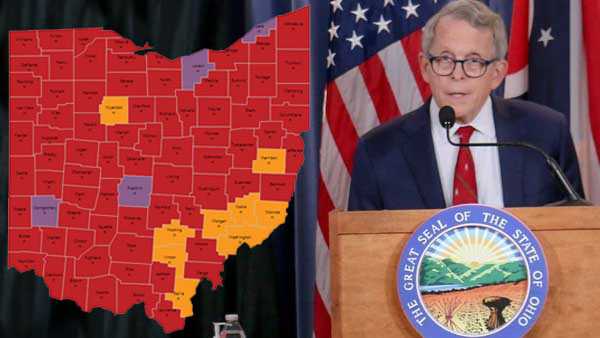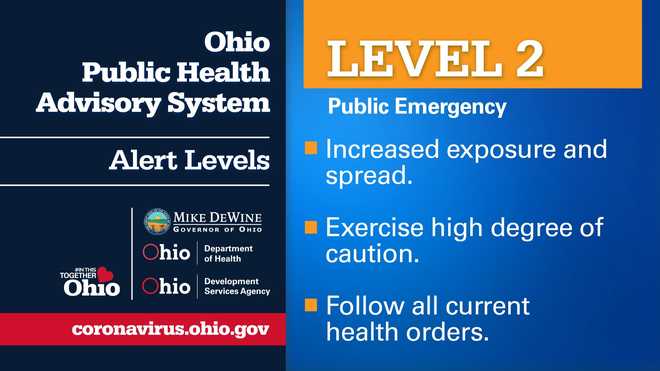Crédito: fuente
WHEN IT COMES TO ADMINISTERING IT, DEWINE SAYS HEALTH OFFICIALS ARE STILL IN THE PLANNING STAGES. >> WE HAVE A DATE THAT LOOKS PRETTY DEFINITE, PRETTY CERTAIN . WE HOPE. REPORTER: ROUND NUMBER ONE OF THE HIGHLY ANTICIPATED COVID VACCINE MAKING ITS WAY TO OHIO AROUND MID DECEMBER, ACCORDING TO GOVERNOR MIKE DEWINE. >> FIRST BATCH SAY AROUND THE 15TH OF DECEMBER AND THEN IT WILL CONTINUE TO COME IN FROM THERE ON. REPORTER: DEWINE SAYS ASSUMING EVERYTHING GETS APPROVED, THAT INITIAL BATCH WILL BE THE PFIZER VACCINE, AND THE SECOND BATCH, MODERNA. BOTH VACCINES AT LEAST 95% EFFECTIVE, BASED ON DATA RELEASED LAST WEEK AND DOCTORS ARE OPTIMISTIC. >> YOU CAN START TO SEE A GLIMMER OF THE LIGHT AT THE END OF THE TUNNEL. REPORTER: THE PFIZER AND MODERNA VACCINES BOTH REQUIRE TWO DOSES . THE SECOND SHOT TAKEN THREE TO FOUR WEEKS AFTER THE FIRST. DEWINE SAYS THE EARLIEST BATCHES WILL GO TO THOSE IN DIRECT CONTACT WITH COVID PATIENTS, LIKE HEALTHCARE WORKERS. CAREGIVERS AND PEOPLE THAT WORK IN NURSING HOMES ALSO PART OF THAT TOP TIER GROU >> WE ARE STILL REFINING THAT AND WE WILL CERTAINLY MAKE THAT ORDER PUBLIC WHEN THAT’S DONE, BUT THAT’S GENERALLY HOW IT’S GOING TO WORK REPORTER: TONIGHT, THE STATE IS REPORTING 8600 NEW CASES. ALMOST 4500 COVID PATIENTS ARE IN OHIO HOSPITALS, FS 2 >>. AND ABOUT A FOURTH OF THEM, IN THE ICU. 98 ADDITIONAL DEATHS ALSO REPORTED. THE GOVERNOR SAYS BETWEEN NOW AND THE START OF NEXT YEAR IS AN ESPECIALLY CRITICAL TIME — CRITICAL TIME. NOW AS FOR UPCOMING THANKSGIVING PLANS, DEWINE SAYS IF WE DON’T SLOW THINGS DOWN AND PULL BACK FROM LARGER GATHERINGS. — GATHERINGS, WE COULD HAVE A, QUOT
4 Ohio counties now purple on state’s advisory system; 11 counties on watch list
Four counties are now listed at the state’s highest risk level on Ohio’s COVID-19 advisory system, and 11 counties are on the governor’s «watch list.»Montgomery, Lake and Lorain counties have moved to the highest risk level (purple or Level 4), joining Franklin County which has been on the list for a second straight week. Montgomery, Lake and Lorain are moving to purple in the alert system because they are experiencing sustained increases in outpatient, emergency and hospital visits by COVID-19 patients, according to Ohio Gov. Mike DeWine. Eleven counties on the verge of turning purple, the governor said. Those 11 counties moving to the watch list are: Adams, Clermont, Hamilton, Medina, Portage, Richland, Stark, Summit, Trumbull, Warren, and Wood counties. «These counties meet enough indicators to be considered at risk level 4 or purple, because of the sustained impact on healthcare utilization,» DeWine said. However, the system requires them to meet these criteria for two weeks in a row to ensure a consistent trend in the data before they become purple.»Ten of the 11 counties on the watch list are in the Akron and Cincinnati regions, which now have fewer adult ICU beds available. This is largely due to increases in COVID-19 ICU patients.“The ongoing high prevalence of the virus throughout Ohio, as reflected in today’s alert system update, is very dangerous as we move into the holidays,” said DeWine. “We have heard again this week from hospital administrators and front-line staff about how they are overwhelmed. It is imperative that Ohioans take the virus and this current situation seriously.” PGRpdiBjbGFzcz0iaW5mb2dyYW0tZW1iZWQiIGRhdGEtaWQ9Il8vNXo0dVRnR01JVnltRm9FT1lPb3IiIGRhdGEtdHlwZT0iaW50ZXJhY3RpdmUiIGRhdGEtdGl0bGU9Ik9oaW8gQ09WSUQxOSBBZHZpc29yeSBTeXN0ZW0iPjwvZGl2PjxzY3JpcHQ+IWZ1bmN0aW9uKGUsaSxuLHMpe3ZhciB0PSJJbmZvZ3JhbUVtYmVkcyIsZD1lLmdldEVsZW1lbnRzQnlUYWdOYW1lKCJzY3JpcHQiKVswXTtpZih3aW5kb3dbdF0mJndpbmRvd1t0XS5pbml0aWFsaXplZCl3aW5kb3dbdF0ucHJvY2VzcyYmd2luZG93W3RdLnByb2Nlc3MoKTtlbHNlIGlmKCFlLmdldEVsZW1lbnRCeUlkKG4pKXt2YXIgbz1lLmNyZWF0ZUVsZW1lbnQoInNjcmlwdCIpO28uYXN5bmM9MSxvLmlkPW4sby5zcmM9Imh0dHBzOi8vZS5pbmZvZ3JhbS5jb20vanMvZGlzdC9lbWJlZC1sb2FkZXItbWluLmpzIixkLnBhcmVudE5vZGUuaW5zZXJ0QmVmb3JlKG8sZCl9fShkb2N1bWVudCwwLCJpbmZvZ3JhbS1hc3luYyIpOzwvc2NyaXB0PgoKYELLOW: ALERT LEVEL 1: A county has triggered zero or one of the seven indicators, and there is active exposure and spread.ORANGE: ALERT LEVEL 2: A county has triggered two or three of the seven indicators, and there is increased risk of exposure and spread.RED: ALERT LEVEL 3: A county has triggered four or five of the seven indicators, and there is very high exposure and spread.PURPLE: ALERT LEVEL 4: A county has triggered six to seven of the indicators, and there is severe exposure and spread. Stay home as much as possible.There are seven different data indicators to determine the four levels, state officials said. Each data indicator helps identify the risk factor for each county. Those seven factors are as follows:NEW CASES PER CAPITA: When the data show that a county has had an average of 50 cases per 100,000 people over a two-week period, that triggers a flag for an increasing case rate. Using this data means we are taking into account population of a county when monitoring case increasesSUSTAINED INCREASE IN NEW CASES: If the number of new cases in a county continually increases, that’s another indicator of virus spread. A county will be flagged for meeting this indicator if the data show at least a five-day period of sustained new case growth.PROPORTION OF CASES NOT CONGREGATE CASES: Data showing more than 50% of new cases originating from non-congregate settings during at least one of the past three weeks will trigger a flag on this indicator.SUSTAINED INCREASE IN ER VISITS: ER data will show us the trend in the number of people who visit an emergency department with COVID-19 symptoms or a COVID diagnosis as a result of the visit. A county is flagged when there is an increase in such ER visits over a five-day period.SUSTAINED INCREASE IN OUTPATIENT VISITS: This data set looks at the number of people visiting outpatient settings, including telehealth appointments, with suspected or confirmed COVID-19 symptoms. A county is flagged when there is an increase over a five-day period.SUSTAINED INCREASE IN NEW COVID-19 HOSPITAL ADMISSIONS: When the numbers show at least a five-day period of sustained growth in the number of county residents with COVID-19 who are admitted to a hospital, the county will be flagged for meeting this indicator.ICU BED OCCUPANCY: This indicator looks at regional data for both COVID-19 and non-COVID use of ICU beds. A county is flagged for this indicator when the regional ICU occupancy goes above 80% for at least three of the last seven days.
Four counties are now listed at the state’s highest risk level on Ohio’s COVID-19 advisory system, and 11 counties are on the governor’s «watch list.»
Montgomery, Lake and Lorain counties have moved to the highest risk level (purple or Level 4), joining Franklin County which has been on the list for a second straight week.
Montgomery, Lake and Lorain are moving to purple in the alert system because they are experiencing sustained increases in outpatient, emergency and hospital visits by COVID-19 patients, according to Ohio Gov. Mike DeWine.
Eleven counties on the verge of turning purple, the governor said.
Those 11 counties moving to the watch list are: Adams, Clermont, Hamilton, Medina, Portage, Richland, Stark, Summit, Trumbull, Warren, and Wood counties.
«These counties meet enough indicators to be considered at risk level 4 or purple, because of the sustained impact on healthcare utilization,» DeWine said. However, the system requires them to meet these criteria for two weeks in a row to ensure a consistent trend in the data before they become purple.»
Ten of the 11 counties on the watch list are in the Akron and Cincinnati regions, which now have fewer adult ICU beds available. This is largely due to increases in COVID-19 ICU patients.
“The ongoing high prevalence of the virus throughout Ohio, as reflected in today’s alert system update, is very dangerous as we move into the holidays,” said DeWine. “We have heard again this week from hospital administrators and front-line staff about how they are overwhelmed. It is imperative that Ohioans take the virus and this current situation seriously.”
YELLOW: ALERT LEVEL 1: A county has triggered zero or one of the seven indicators, and there is active exposure and spread.
ORANGE: ALERT LEVEL 2: A county has triggered two or three of the seven indicators, and there is increased risk of exposure and spread.
RED: ALERT LEVEL 3: A county has triggered four or five of the seven indicators, and there is very high exposure and spread.
PURPLE: ALERT LEVEL 4: A county has triggered six to seven of the indicators, and there is severe exposure and spread. Stay home as much as possible.
There are seven different data indicators to determine the four levels, state officials said. Each data indicator helps identify the risk factor for each county. Those seven factors are as follows:
- NEW CASES PER CAPITA: When the data show that a county has had an average of 50 cases per 100,000 people over a two-week period, that triggers a flag for an increasing case rate. Using this data means we are taking into account population of a county when monitoring case increases
- SUSTAINED INCREASE IN NEW CASES: If the number of new cases in a county continually increases, that’s another indicator of virus spread. A county will be flagged for meeting this indicator if the data show at least a five-day period of sustained new case growth.
- PROPORTION OF CASES NOT CONGREGATE CASES: Data showing more than 50% of new cases originating from non-congregate settings during at least one of the past three weeks will trigger a flag on this indicator.
- SUSTAINED INCREASE IN ER VISITS: ER data will show us the trend in the number of people who visit an emergency department with COVID-19 symptoms or a COVID diagnosis as a result of the visit. A county is flagged when there is an increase in such ER visits over a five-day period.
- SUSTAINED INCREASE IN OUTPATIENT VISITS: This data set looks at the number of people visiting outpatient settings, including telehealth appointments, with suspected or confirmed COVID-19 symptoms. A county is flagged when there is an increase over a five-day period.
- SUSTAINED INCREASE IN NEW COVID-19 HOSPITAL ADMISSIONS: When the numbers show at least a five-day period of sustained growth in the number of county residents with COVID-19 who are admitted to a hospital, the county will be flagged for meeting this indicator.
- ICU BED OCCUPANCY: This indicator looks at regional data for both COVID-19 and non-COVID use of ICU beds. A county is flagged for this indicator when the regional ICU occupancy goes above 80% for at least three of the last seven days.














